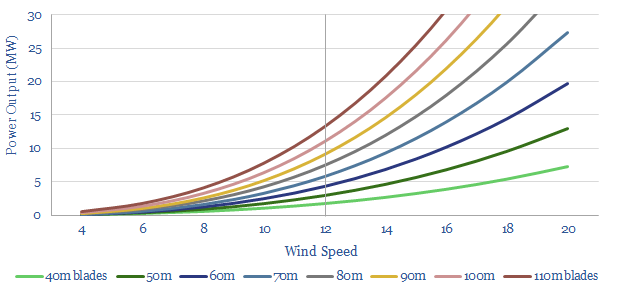Some commentators expect the levelized costs of offshore wind to fall another two-thirds by 2050. The justification is some eolian equivalent of Moore’s Law. Our 16-page report draws five contrasts. Wind costs are most likely to move sideways, even as the industry builds larger turbines. Implications are explored for companies.
Deflating wind costs are explored on pages 2-3. Deflation is important. But consensus forecasts could be dangerously wrong in our opinion.
Our report lays out five reasons why wind looks different to Moore’s Law, which has doubled computing performance every 18-months since 1965.
(1) Offshore wind costs are not following Moore’s Law yet. And after reviewing 50 patents from one of the world’s leading wind developers, we think the industry’s largest focus is not on costs (pages 4-5)
(2) Making turbines ever-larger is “the opposite” of making transistors ever-smaller. We review the physics and a simple issue around extrapolation (pages 5-6)
(3) Larger turbines face larger challenges. Unlike Moore’s Law, physics “work against” the up-scaling of wind turbines (pages 7-9).
(4) Larger turbines are more carbon intensive, using advanced materials that are 10-25x more costly and CO2-emitting, paradoxically requiring more fossil fuels. This looks like “the opposite” of the bootstrapping that helped propel Moore’s Law (pages 10-13)
(5) Wind turbines crowd out wind turbines, as grids ultimately become saturated with highly inter-correlated wind generation. This re-inflates marginal costs. Again, this is the opposite of bootstrapping (pages 14-15).
Our conclusions for companies are drawn out on page 16.

